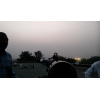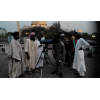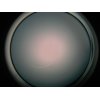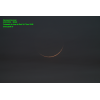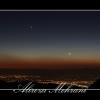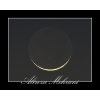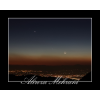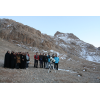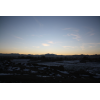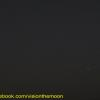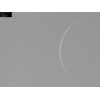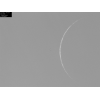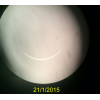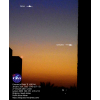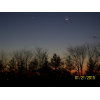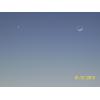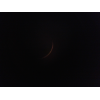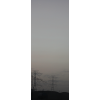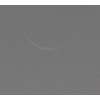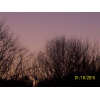Visibility of Rabee' Al-Aakher Crescent 1436 AH
- When to Observe Rabee' Al-Aakher Waxing (NEW) Crescent ?
- Rabee' Al-Aakher Waxing (NEW) Crescent Observation Results
- The OFFICIAL First Day in Different Countries
- When to Observe Rabee' Al-Awwal Waning (OLD) Crescent ?
- Rabee' Al-Awwal Waning (OLD) Crescent Observation Results
When to Observe Rabee' Al-Aakher Waxing (NEW) Crescent ?
The geocentric conjunction (Geocentric New Moon) will occur Inshalla on (Tuesday 20 January 2015) at 13:14 UT.
Sighting the new crescent on (Tuesday 20 January 2015) and (Wedensday 21 January 2015) is shown in the below graphs using the program Accurate Times by Mohammad Odeh according to Odeh criterion. Where:-
- It is impossible to see the crescent from the areas located under the red color. Because either the Moon on this day sets before the Sunset and/or the topocentric conjunction occurs after the Sunset.
- The crescent is expected to be seen by optical aid only from the areas located under the blue color.
- The crescent is expected to be seen by optical aid from the areas located under the magenta color. In these areas the crescent could be seen by naked eye if the atmospheric conditions are superb and the observer is experienced.
- The crescent is expected to be easily visible by naked eye from the areas located under the green color.
- The crescent cannot be seen from uncolored areas, even though the Moon sets in these locations after the Sunset and the topocentric conjunction occurs before the Sunset, but the Moon is not sufficiently illuminated in order to be seen as crescent even by optical aid.
- Kindly notice that the below graph shows the possibility of seeing the crescent from areas between 60 degrees north of Equator down to 60 degrees south of Equator.


According to the Universal Hejric Calendar (UHC), which is based on the calculated crescent visibility, the start of this month in the Eastern Region will be on Thursday 22 January 2015 and in the Western Region will be on Wedensday 21 January 2015. Kindly notice that the UHC is a pre-calculated calendar, which adopts a certain criterion to start the new Hejric month. Your country/organization might adopt different criterion to start the new Hejric month. So it is highly advised to read the UHC website before giving any judgment.
- Results of seeing the crescent, and the first day of the month in different countries will be added here Inshalla as we receive the reports from ICOP's members. If you wish to be a member in ICOP, or to know more about it, kindly click here.
Rabee' Al-Aakher Waxing (NEW) Crescent Observation Results
Tue 20 January 2015
France
Mr. Farid Fofana said: "لمعرفة جميع نتائج الرصد في مواثع الرصد الخمسة يرجى زيارة موقعنا WWW.OLMF.FR"
Nigeria
Mr. Qamarudeen Muhammad said: "I and other members of National Moon Sighting Committee of Nigerian Supreme Council for Islamic Affairs tried to searchh and sight for new hilal of Rabiul Thanni in spite of good western sky, we could not see the hilal. Also, in phone call made to various observers across the country, no one are able to claim positive sighting of the hilal. Officially, NSCIA has declared Thursday 22 January 2015 as first day of Rabiul Thanni after month of Rabiul Awwal run for thirty rays."
Saudi Arabia
United States
Dr. Javad Torabinejad said: "I arrived at my sighting location (Blacksburg Middle School) before sunset (sunset: 5:33 pm EST). Soon after, using binoculars (7X50 and 10X50), I started scanning the partly cloudy western horizon with no success. While Venus was easily visible, I could not see Mercury. I ended the session a few minutes before the moonset (moonset: 6:06 pm)."
Wed 21 January 2015
Australia
Bangladesh
Egypt
France
Mr. Farid Fofana said: "لمشاهدة جميع نتائج الرصد في المواقع الخمسة يرجى زيارة صفتحنا WWW.OLMF.FR"
Ghana
Mr. Baba Abdulai said: "Date of sighting effort; Wednesday 21ST January, 2015. The crescent was NOT seen in this location. I was at the sighting post from about 18:35 to about 19:00 but I did not see the crescent. There was virtually no trace of any clouds in the sky; however the sky was dusty. Sighting community; Sagnerigu, Tamale. Considering that the crescent must have been about 29 hours old (after conjunction) as at sunset in Tamale and with a moon lag time of about 1 hr 7 mins, I still find it hard to believe that I never sighted it. And Allah (SWT) Knows Best."
Indonesia
Mr. AR Sugeng Riyadi said: "The new crescent of Rabi'ul Akhir 1446 AH was NOT SEEN from Assalaam Observatory on Wednesday 21st January 2015 because the sky was rainy. We were about 30 students of CASA (Club Astronomi Santri Assalaam) at Surakarta."
Iran
Mr. Hossein Janghorbani said: "In the name of God Rabee' Thani Crescent Observation Report Astronomy and Geophysics Center of Shahreza – The Crescent Association of Shahreza Report by: Hossein Janghorbani (Najm-al-Sepehr) – Manager of Shahreza Crescent Association and Red Crescent’s Astronomy and Geophysics Center Date: Wednesday, 1/21/2015 Location: Damzad foothills in the East of Shahreza (latitude: 32 00 N, longitude: 51 52 E, elevation: 1825m from sea level, time zone: +3.5 GMT) Equipments: two set of 15*70, one sets of 20*90 binoculars, one sets of 20*80 binoculars ,one sets of 8” Schmidt Newtonian Telescope , one compass. Atmospheric condition: Clear. Horizon obstacles: about 2.5° Apparent sunset: 17:13 Results: Moon crescent was seen by 20*90 binoculars by Mahsa Khajeh at 17:13, for the first time. Other group members observed crescent by binoculars and 8” Telescope subsequently. Crescent observed by Reza Janghorbani 17:35 by naked eye. Other group members observed crescent by naked eye Observers : 1.Tayebeh Shafiee 2.Narjes zare 3.Zinat Ghermezi 4.Fatemeh Tavakoli 5.Fatemeh Haddad 6. Shakiba Moslehi 7.Mohadeseh Alinezhad 8. Zahra Farrokhpoor 9.Ziba Hafar 10.Narges Shahnazari 11.Mahsa Khajeh 12.Najmeh Ghasemi 13.Zahra Fallahi 14.Sayed Abolfazl Kahangi 15. Mahdi Ghasemi 16.Mohammad Javad Nikeghbal 17.Shahram Feyzi 18.Mahmud Aliabedi 19.Reza Janghorbani 20.Ali Janghorbani 21.Hossein Janghorbani "
Libya
Eng. Mohammed Abdulkarim said: "تمت الرؤية بالعين المجردة بعد 12 دقيقة من غروب الشمس وكانت الرؤية صعبة قبل هذا الوقت، وقد التقطت هذه الصورة للهلال على تمام الساعة 18:31 وهو على إرتفاع 9 درجات وبنسبة إضاءة 1.8 % من إضاءة القمر الكامل، كما رصدت الزهرة ولم أرصد عطارد وذلك بسبب عدم صفاء الجو بشكل تام. الصورة المرفقة الأولى للهلال على تمام الساعة 18:31 بتوقيت ليبيا والثانية جمعت ما بين الهلال وكوكب الزهرة."
Netherlands
Mr. Sander Helmig said: "The sky was very clear, accept for the west horizon. Nevertheless I saw the cresent very clear just above the clouds."
Nigeria
Mr. Yunusa Yakubu said: "the atmospheric condition is a bit hazy in that sun sets @ 18:15. Alhamdulillah at 18:38 LT the crescent was easily visible by naked eye at the right point of sunset seen by many even the passers by. Allahumma ahhillahu bil Amni wal Iman, Bissalamati wal Islam. "
Dr. Z.Sani Mustapha said: "According to hisab the moon appears today but is not so according to the sunna. It is not sighted."
Oman
Prof. Mohammed Al-Bussaidi said: "The weather was very clear and the crescent was sighted immediately."
Saudi Arabia
Eng. Qamar Uddin said: "I did not personally see the hilal today (21/1/2015) as I was travelling back from Riyadh, but thanks to my local contact for sharing the sighting report with the hilal photo attached."
Eng. Muflih Arisa Adnan said: "The sky was very clear, no cloud. The crescent was seen before it could be taken. I should wait until the sky getting darker in order to capture the picture. I just used a camera from my mobile phone Lenovo S650."
Dr. Ayyub Patel said: "Assalaamu alaykum w.w. Today 21st Jan 2015 local Abha, Saudi Arabia time 6.15pm some 15 min we observed and witnessed the crescent moon, waxing new moon for Rabi3 athani Islamic month. the hilal was visible for around 40 minutes. By the pre-calculated Saudi UmmulQura calenar it was already the 1st of Rabi3 athani today. On 20th it was immopissible to sight due the age of the moon being only a few hours. We first saw the planet venus then the crescent hilal."
South Africa
Dr. Abdurrazak Ebrahim said: "In South Africa there are three regular Hilaal sighting localities, viz., Durban, Johannesburg, and Cape Town. The weather at all three localities was unfavourable for a positive result/"
Sri Lanka
Mr. Nular Bary said: " Assalamualaikum W R W B. Today 29th.of Rabi-al-Thani1436H (21/01/2015) the Hillal of Rabi -al-Thani was sighted by me & several other observers of The Colombo Grand Mosque Hillal Committee in several places this evening. Hence we will start our Month of Rabi al- Thani on Thursday 22nd.of January 2015 "In Sha Allah" "
United States
Dr. Javad Torabinejad said: "Afternoon: To find the moon's position, I used the Sky & Telescope Interactive Sky Chart. First, I located Venus and then at 2:21 pm sighted the crescent to its upper right. The horns were at 3:00 and 6:30 O'clock (3:00;4:30;6:30). I did not try hard to sight the crescent with naked eye. Perhaps, it was not possible to see it, although Venus was sighted. Evening: Again this evening, I sighted the crescent. On the way going to my sighting location (the Blacksburg Middle School), I sighted the moon at 5:43 pm (sunset: 5:34 pm). The horns were at 3:00 and 8:30 O'clock (3:00;5:00;8:30). At this time, Venus was to its left. The western horizon was mostly clear. Using a pair of 7X50 binoculars, it was around 6:00 pm when I looked for Mercury and found it below the moon. Later, it was sighted by naked eye. I left the area around 6:20 (moonset: 7:17 pm). "
The OFFICIAL First Day in Different Countries
Wed 21 January 2015
1 . Nigeria
2 . Saudi Arabia
Thu 22 January 2015
1 . Bangladesh
2 . Indonesia
3 . Iran
4 . Netherlands
5 . Nigeria
6 . Oman
7 . Sri Lanka
Fri 23 January 2015
1 . Australia
2 . South Africa
When to Observe Rabee' Al-Awwal Waning (OLD) Crescent ?
The geocentric conjunction (Geocentric New Moon) will occur Inshalla on (Tuesday 20 January 2015) at 13:14 UT.
Sighting the OLD crescent on (Tuesday 20 January 2015) and (Monday 19 January 2015) is shown in the below graphs using the program Accurate Times by Mohammad Odeh according to Odeh criterion. Where:-
- It is impossible to see the OLD crescent from the areas located under the red color. Because either the Moon on this day rises after the Sunrise and/or the topocentric conjunction occurs before the Sunrise.
- The crescent is expected to be seen by optical aid only from the areas located under the blue color.
- The crescent is expected to be seen by optical aid from the areas located under the magenta color. In these areas the crescent could be seen by naked eye if the atmospheric conditions are superb and the observer is experienced.
- The crescent is expected to be easily visible by naked eye from the areas located under the green color.
- The crescent cannot be seen from uncolored areas, even though the Moon rises in these locations before the Sunrise and the topocentric conjunction occurs after the Sunrise, but the Moon is not sufficiently illuminated in order to be seen as crescent even by optical aid.
- Kindly notice that the below graph shows the possibility of seeing the crescent from areas between 60 degrees north of Equator down to 60 degrees south of Equator.
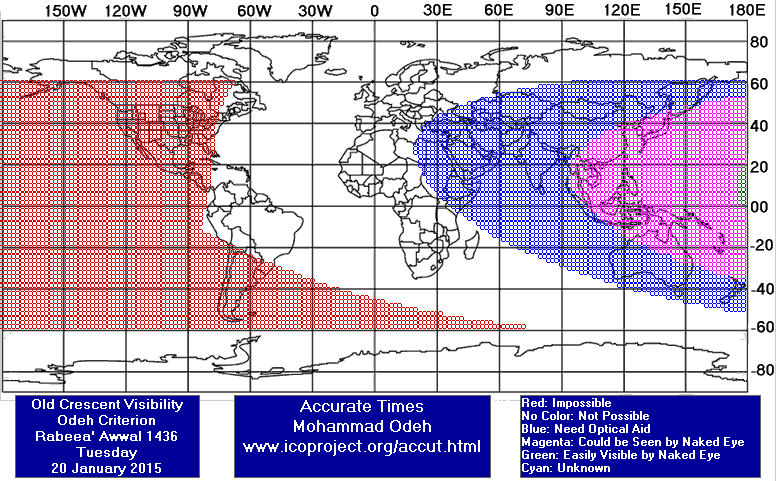
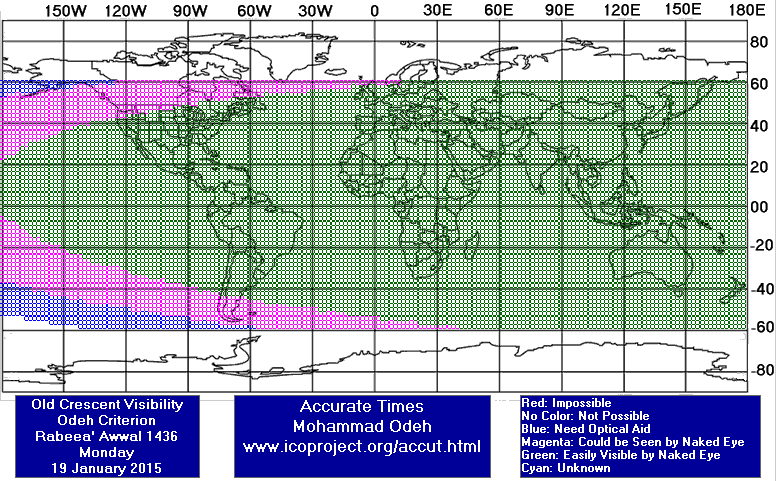
Rabee' Al-Awwal Waning (OLD) Crescent Observation Results
Mon 19 January 2015
Egypt
Ghana
Mr. Baba Abdulai said: "Fajr Salaat was around 5:00 am. I sighted the crescent sometime after Fajr Salaat, but i am not very sure of the exact time. Location of sighting effort = Sagnerigu Community, Tamale."
Indonesia
Nigeria
Dr. Z.Sani Mustapha said: "The crescent seen at 5.57 am shows that it cannot be seen the next day 20/01/2015. "
Saudi Arabia
Dr. Ayyub Patel said: "Pictures attached Old waning crescent seen from abha in the morning of 19th jan 2015 between 6.15 and 6.50am"
United States
Dr. Javad Torabinejad said: "It was just past 7:00 am EST when I saw the crescent with naked eye (sunrise: 7:33 pm). The horns were at 5:30 and 9:00 O'clock (5:30;7:00;9:00)."

